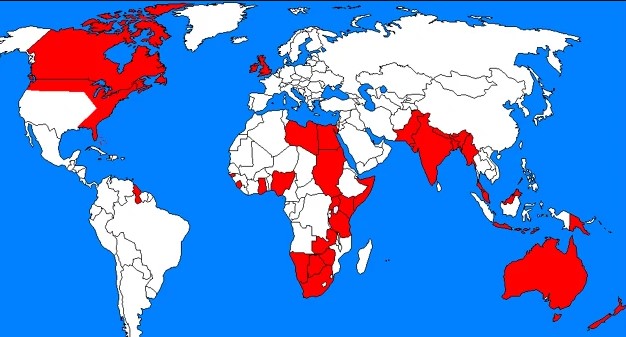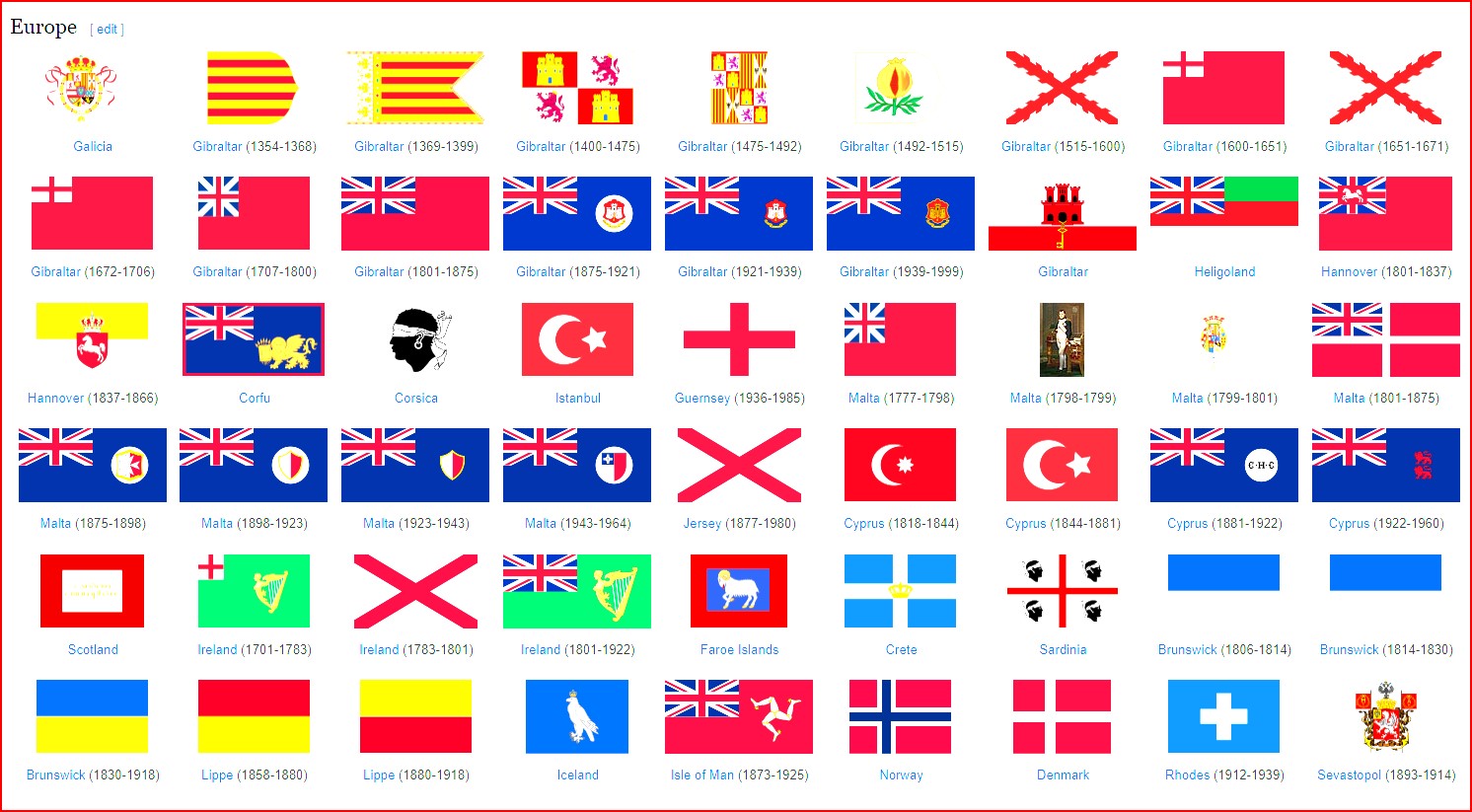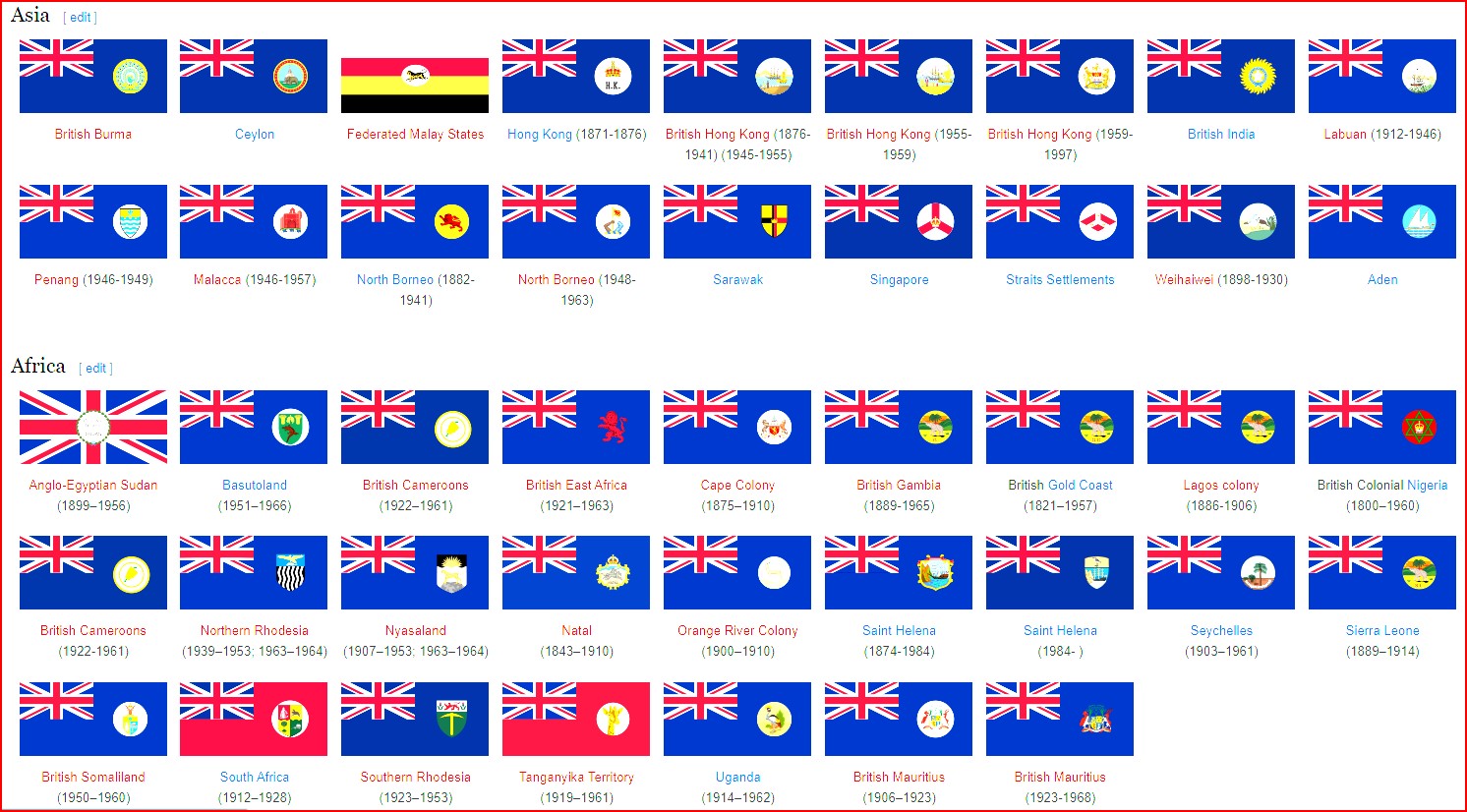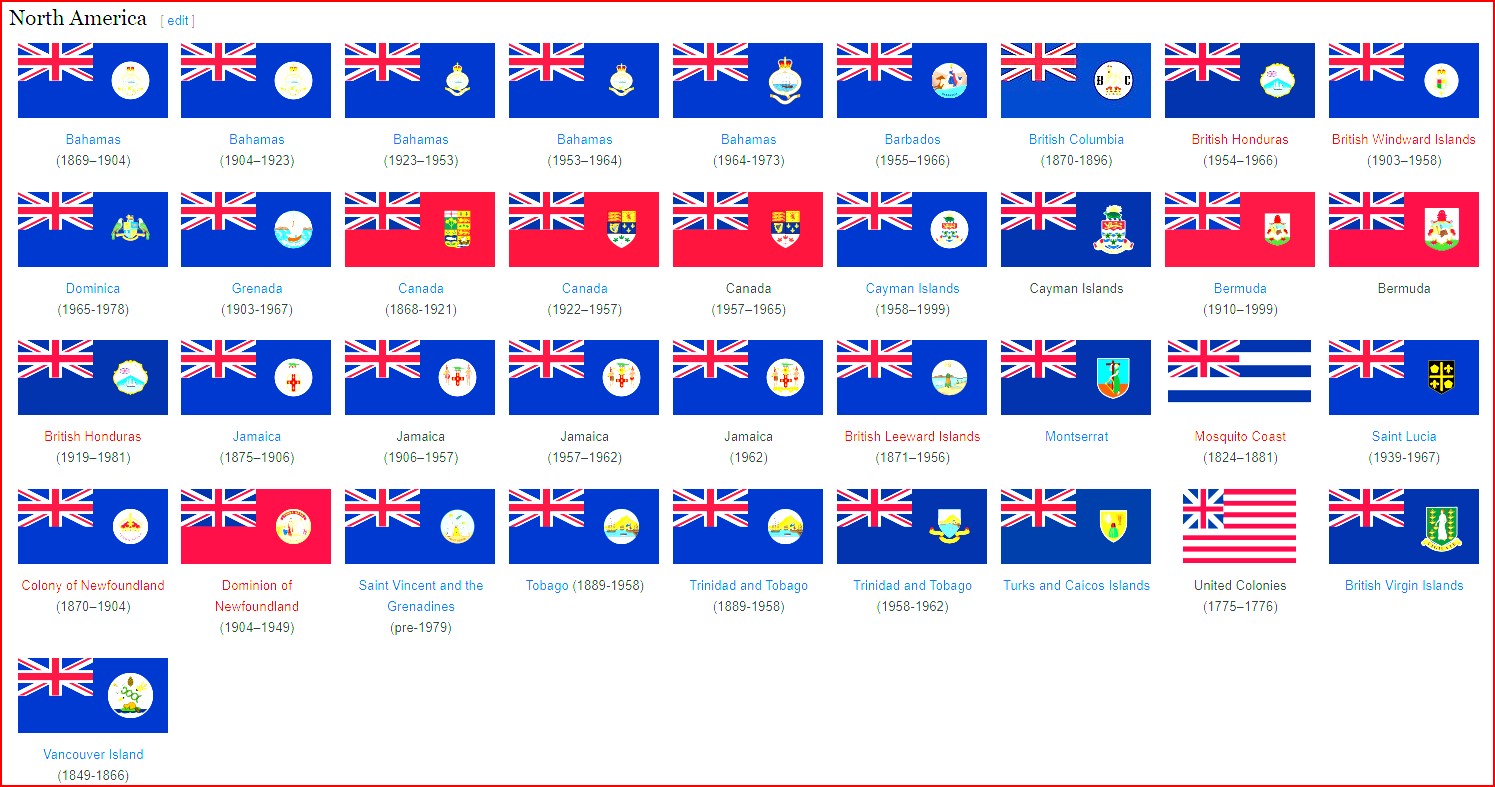The British Empire - Rise and Fall
Author: Robert W. Penry @ 2023


Throughout history, mighty empires have risen and then faded into obscurity. The Roman Empire existed for nearly 500 years and at its peak, ruled most of Europe, the near Middle East and Northern Africa. By the 5th Century A.D. (C.E.) it was gone.
The British Empire lasted 200 years, and ruled over one quarter of the Earth’s population, and yet collapsed in a 20-year period. This article will examine the reasons for both the rise and fall of the mighty British Empire. The British Empire consisted of the British Isles, ruled by England, the mother country, and also British Colonies and countries that were ruled or controlled from England by agreements or military presence. The historical viewpoint the the British Empire started in the 16th century with the establishment of overseas colonies. By 1783, the empire was largely completed.
How did a small island in the North Atlantic manage to rule one fourth of the world’s population? What does a country need in order to build an empire? I believe that these are the needed traits.
1. A strong central government. Two dynasties were in power during the height of the empire, the Hanover and the Saxe-Coburg. During the Hanover period, the real power lay with Parliament. However, during the Saxe-Coburg (which became Windsor during WWI, Queen Victoria was a powerful ruler, loved throughout the British Empire. Eventually the Monarchy became less involved, and more ceremonial. Parliament was particular powerful, with a secession of strong, influential Prime Ministers.
2. Ability to travel great distances. England built one of the strongest naval fleets, both trading and military in the world. It eventually conquered the Spanish fleet, and emerged as the world’s most powerful Navy. All of the major powers had access to the sea. No landlocked empire ever gained the influence of sea-accessible nations.
3. Diplomatic Masters. England was especially astute in this area, particularly in India making deals with local Maharajas. The people would perceive government coming from the Maharaja, but in reality, it was England pulling the strings in the background. This illusion made it possible to control large populations with a very small contingent of diplomats and military. Later on, we will see how this illusionary power eventually led to the decline of the British Empire.
4. Ability to intimidate. England had this down to a science. If you look and act tough, the natives will think you are dangerous and obey. This was especially true in India. If you act weak, people will ignore you or perhaps even fight. The colonial governors were usually strict, and laws and rules were always enforced. The danger lies if those being controlled are able to see through the illusion.
5. Masters of ceremony and pageantry. I travel the world and I always try to go native; I don’t try to stand out. The British did the opposite. Instead of adopting local customs, dress, ceremony, and lifestyles, the British brought Britain along with them. By this, I mean they dressed in English finery, brought in afternoon tea, cricket, and other English customs and expected the native population to adopt. Fortunately for Britain, this worked very well in India. The Indians were impressed and tried to become British. Even today, long after the departure of Britain, many of these customs, especially, polo, cricket, and soccer dominate Indian sports. Another was architecture. One of India’s most famous and loved mausoleums is the Taj Mahal. England copied it, by building the Victoria Memorial, a large marble building copying Indian architecture to house the British government offices and to honor Queen Victoria. The Maharajas loved ceremony which the English encouraged. Parades and pageantry were commonplace during the colonial era. The military parade uniforms always displayed medals and plenty of gold braid. All of this was designed to portray the magnificence of the British way of life.
Empires are not built overnight. They are built by a combination of exploration, settlement, trade, conquest and treaties.
At the time when exploration, trade and settlement were taking place, countries as we see today did not exist. The world was fragmented into tribal areas. These varied in size but were ruled over by leaders of Tribes, Kingdoms, Principalities, Dynasties, or Clans.
Wales had Celtic Tribes, the Ordovices, the Deceangli, the Gangani, the Demetae, and the Silures. These eventually became principalities ruled over by a prince, the leader of a family whose power was usually gained by conquest over other families.
Scotland had Clans. These were family dynasties ruled over by a Clan Chief. They were warlike, expanding their clan areas by conquering other clans. These resulted in many feuds, such as the Campbells and the MacDonalds. Even today there in animosity between these two families.
In 843 one clan became powerful enough to rule the nation, the Was Kenneth I MacAlpin, son of Alpin, King of Dál Riata, a Gaelic kingdom of what is now western Scotland and north-eastern Ireland.
Ireland was divided into many semi-independent territories, reported to be about 150. Each territory was ruled over by a dynastic family whose leader was called King. Eventually, two main branches emerged as High Kings of the Northern and Southern branches of the Uí Néill; two dynasties who claimed to be descendants of a single historic king. Only one king came close to being a ruler over all of Ireland, High King Brian Boru. Dynastic disputes continued and Brian Buru was killed in battle in 1014. Warfare and disputes continued until the Norman invasion in 1169.
England started as a series of Celtic tribes which were then conquered by Anglo-Saxon invaders, who in turn were conquered by the Normans in 1066. Viking settlements along the North, and Irish sea continued until eventually being absorbed into England and Wales. The ruler of England were dynastic.
Over time, England became to conquer and possess its neighbors in the British Isles. Perhaps the first English colony was Ireland which was ruled by tribes until Anglo-Norman invasions in the 12th Century. Wales was annexed by England in 1287 by the Statute of Wales. Britain as a power being ruled by the English Monarch finally occurred with the Act of Union in 1707 which combined England and Scotland.
By this date, however, Britain had colonies and influence throughout the World. It is impossible to establish a definite date for the start of the British Empire. Some historians say 12th Century with the invasion of Ireland. Others say the 16th century when British ships began sailing the seas and establishing colonies in the Americas and the islands of the Pacific.
After the discovery of the Americas in the 15th Century by Christopher Columbus, European powers, especially England, France, Holland, Spain, and Portugal begin settling in the Americas and establishing trade centers throughout the world.
In the Caribbean, the major powers started claiming and settling the many islands. Their control and influence still exist. Control of the sea was crucial and these powers began fighting for control,
Earlier, British strategy and influence in India was covered. This was not so in the West Indies, the Caribbean. If we could define the British that colonized there, we might use these terms: pirates, gangsters, cruel, arrogant, and slavemasters.
The English discovered that the Caribbean Islands were perfect for growing sugarcane for molasses and rum, and tobacco, and cocoa, a highly lucrative business. Of importance were allspice and vanilla. Other agriculture crops such as beans, sorghum, peppers, pumpkin, eggplant, onion, melon, pepper, cucumber, tomato and yam, tamarind, cashew, mango, avocado, guava, papaya, and coconut could also be grown.
The English quickly started a plantation society and enslaved the native population, the Carib Indians. Unfortunately, the English also brought European diseases which just as quickly decimated the native population. The English soon replaced native workers with African Slaves. The English became masters of the Slave Trade which lasted until 1833. And of course, the benevolent English made sure that the slaves were treated fairly! Later on, we will examine how this treatment eventually helped in the decline of the British Empire.
Exploration
Exploration and discovery and are not the same thing. We tend to see discovery from a Euro-centric point of view. Columbus didn’t really discover America. The Vikings were in Canada long before 1492. To discover a land would mean that it was a place uninhabited. The islands of the Caribbean were occupied by natives. So, the term discovery from the European point of view is to acquire possession. Very little land was truly discovered in the sense of being uninhabited.
Exploration means to examine something. Explore in the Euro-centric point of view is to visit a land and discover ways to exploit it.
There were many British explorers. British discoverers were few, easily named on the fingers of one hand.
The most prominent discoverers:
James Cook 1728-1779. British explorer, navigator, and cartographer. He is credited with discovering Australia, New Zealand, and Hawaii. He tried to kidnap a Hawaiian King and was killed.
Francis Drake 1540-1596. British explorer and naval officer. Claimed what is now California for England which he called New Albion.
Henry Hudson 1565-1611. Discovered Hudson Strait and Hudson Bay. Explored Canda, and what is now northeastern United States
Famous Explorers:
Walter Raleigh 1552-1618. British explorer, writer and politician. Trips to both North and South America. Introduced England to tobacco. Responsible for the legend of El Dorado in South America.
David Livingstone. British physician and explorer. Remembered for missionary work in Africa
John Smith 1580-1631. British explorer. Founded first permanent English settlement in North America, Jamestown in the early 1600’s.
Settlement
When Columbus landed in the Americas (perhaps on Hispaniola Island) in 1492, he claimed his discovery for Spain. However, he didn’t realize that to his north and southwest were two huge continents. As settlers arrived from various European countries, claims were made for the various mother countries. However, no one country claimed entire continents. More colonies were formed by settlement than any other method. After Ireland, the English settled Bermuda, parts of the West Indies, Canada and the American colonies along the eastern seaboard.
After the discovery of the Americas in the 15th Century by Christopher Columbus, European powers, especially England, France, Holland, Spain, and Portugal begin settling in the Americas and establishing trade centers throughout the world.
In the Caribbean, the major powers started claiming and settling the many islands. Their control and influence still exist. Control of the sea was crucial and these powers began fighting for control,
Earlier, British strategy and influence in India was covered. This was not so in the West Indies, the Caribbean. If we could define the British that colonized there, we might use these terms: pirates, gangsters, cruel, arrogant, and slavemasters.
The English discovered that the Caribbean Islands were perfect for growing sugarcane for molasses and rum, and tobacco, and cocoa, a highly lucrative business. Of importance were allspice and vanilla. Other agriculture crops such as beans, sorghum, peppers, pumpkin, eggplant, onion, melon, pepper, cucumber, tomato and yam, tamarind, cashew, mango, avocado, guava, papaya, and coconut could also be grown.
The English quickly started a plantation society and enslaved the native population, the Carib Indians. Unfortunately, the English also brought European diseases which just as quickly decimated the native population. The English soon replaced native workers with African Slaves. The English became masters of the Slave Trade which lasted until 1833. And of course, the benevolent English made sure that the slaves were treated fairly! Later on, we will examine how this treatment eventually helped in the decline of the British Empire.
Trade
The East India Company began establishing trading posts in India in 1600, and the first permanent British settlement in Africa was made at James Island in the Gambia River in 1661.
Trading posts called “factories” were established Bantam in the East Indies and Surat in the Indian subcontinent. Then in 1639 a series of fortresses were established along the Indian Coast. At this time, India was not a country under single rule. There were many areas ruled my Maharajas
Conquest and Treaties
When the British came to a new territory, the native inhabitants were not at the same technological level as the British. It was easy to conquer them. Muskets, swords, and cannons are more formidable and powerful than spears, bows, and arrows.
There is a dictionary definition of a treaty. My own definition more closely matches the British idea of a treaty. For the British, the idea of a treaty was to end a hostility and was kept until the British decided it was time to break it! Seems harsh, but very true. All nations follow this pattern. Consider the United States treaties with Native Americans and Germany with the Treaty of Versailles. Besides formal treaties, deals are often made secretly. Treaties and secret deals always favor the most powerful side. These treaties and deals were instrumental in both the rise and fall of the British Empire and will be discussed further.
I lived in the British Isles for three years and observed attitudes and beliefs of the people. I made many friends. But I also had to occasionally deal with the arrogance of some. Even though we were allies in WWII, many soldiers remember “Overpaid, Oversexed, and Over Here.” In Scotland, someone painted on the wall surrounding my RAF base, “Yankee go Home” but underneath that phrase, someone had written “And Take Me With You!” My point is, at the personal level, friendships occur, but at the political level, nations can be allies, but that does not necessarily mean that they are friends. Treaties prove this point!
Britain, France, Russia, Austria and Prussia fought in the Seven Years’ War (1756-1763) for global supremacy. Two treaties resulted in 1763, the Treaty of Hubertusburg, and the Treaty of Paris.
Treaty of Paris – 1763. For Britain, its part in the North American, Franch and Indian War, resulting in the French losing its North American possessions, except for New Orleans and some concessions made for Quebec. Britain gained Canada and most of what is now the United States east of the Mississippi River. But Britain gained what would be an even greater prize – India! However, the Seven Year’s War had bankrupted Britain which desperately needed funds. Parliament knew that the American colonies had funds, and since they were just a bunch of backwards yokels who had no vote in parliament, some really heavy taxes were levied on the colonies. Hey, we like our tea, leave it alone! This worked out really well for the British until the 13 colonies rebelled! This leads us to our next treaty.
Treaty of Paris – 1783. (Yes, there were two Treaties of Paris.) The second one was to end the American Revolution. This time, England lost its possessions south of Canada, which loss, once again meant that Britain needed funds. So, England sent Captain James Cook to explore the Pacific. He then saw that both Australia and New Zealand could be great sources of income and also went on to discover Hawaii, another possibility, until he decided to kidnap the Hawaiian King BAD MOVE! The native Hawaiians killed him.
India, the Great Prize. The 1763 Treat of Paris saw France giving up its influence in India, allowing the British entrance. This large nation could bring, mineral and food resources, manpower, and prestige. Britain had to find ways to utilize and control a country of millions of people. Britian could not begin to muster enough military to control. How did they do it? They funded Indian military units to fight for Britain and furnished arms and British Officers to lead. It worked. Indian troops fought for Britain across the globe,and gave their allegiance to Britain.
The British also made treaties with local leaders, the Maharajas. The people would obey these local leaders, not knowing that Britain was in the background pulling the strings. In Calcutta alone, 2600 British were able to control two million Indians! Eventually, the British helped the Maharajas build magnificent palaces, and then stripped them of power, but allowed them to continue living ceremonially, keeping their palaces.
The British also held parades and huge ceremonies meant to dazzle the Indians and provide the illusion of great power. Britain was a paper tiger in India. This would eventually lead to Britain’s downfall. Besides the palaces, Britain also built the Victoria Monument to commemorate Queen Victoria and promoted her image throughout India, almost as a demi-god. The Victoria Monument was the seat of British Government and was often called the second Taj Mahal.
Earlier, I discussed how Britain brought their culture to India, sports, leisure activities, afternoon teas, and English clothing styles. Even today in India, sometimes it’s almost like being in England. The people adopted the English customs readily. This contributed to the ability to control and dictate. By 1770, the British has discovered Australia. After the loss of the American Colonies to the United States, England needed to replace lost lands and in 1788 colonized Australia to be used as a penal colony. However, England also encouraged emigration to Australia and New Zealand and soon enormous stations (ranches) were established to raise sheep and cattle.
Britain also exported its culture to other colonies such as Ceylon, Singapore, South Africa, New Zealand, Mauritania, Bermuda, the Falklands, and the Islands of the Caribbean. Even today, the British influence the world. The United States embraces British movies, and music, and even likes hiring people with British accents. Hiring a DJ with a British accent is a coup for a radio station.
Countries that have been colonial parts of the British Empire - Those in broad-face font are still part of the Commonwealth of Nations (former British Empire)






Atlantic/Caribbean
Bermuda – British Overseas Territory
Bahamas 1718-1963 Independent (Still British Overseas Territory)
Turks and Caicos – 1783 – British Overseas Territory
Belize Ambergris Caye – 1848 (now part of Belize)
Corn Islands 1655 – 1971 (now part of Nicaragua)
Provencia 1803-1912) – (Now Columbia)
San Andres – 1627 – 1792 – Now Columbia
Jamica – 1655 – 1962 – Independent
Cayman Islands – 1661 – present British Overseas Territory
Antigua and Barbuda – Antigua 1632, Barbuda 1678. Independent in 1981. Still part of British Commonwealth
Barbados – 1627 – 1966 – independent British Commonwealth
Federation of Saint Kitts and Nevis – Nevis 1628 St Kitts 1713
Montserrat 1632- Present – British Overseas Territory
Anguilla – 1650 Present – British Overseas Territory
Tortola 1672 – Present largest of the British Virgin Islands 1648 – 1672 -Dutch
Anegada 1672 – “
Jost Van Dyke – “
Trinidad and Tobago, Republic (Independent 1962, Republic in 1976)
Dominica 1715 – 1978 Independent (French 1673 – 1715)
Saint Lucia – 1814 – 1979 Independent (French 1643 – 1814)
Saint Vincent and the Grenadines
Grenada – 1763 by Treaty of Paris – recaptured by France but restored to Britain in 1783- Independent 1974 part of British Commonwealth
World-Wide
Australia
Bangladesh
Botswana
Brunei
Cameroon
Canada
Cyprus
Eswatini (formerly Swaziland?)
Fiji
The Gambia
Ghana
Guyana
India
Kenya
Kiribati
Lesotho
Malawi
Malaysia
Maldives
Malta
Mauritius
Mozambique
Namiba
Nauru
New Zealand
Nigeria
Pakistan
Papua New Guinea
Rwanda
Samoa
Seychelles
Sierra Leone
Singapore
Solomon Islands
South Africa
Sri Lanka
Tanzania
Tonga
Tuvalu
Uganda
Vanuatu
Zambia
FORMER MEMBERS
Ireland
Zimbabwe
DISSOLVED MEMBERS
Malaya
Newfoundland
Tanganyika
Zanzibar